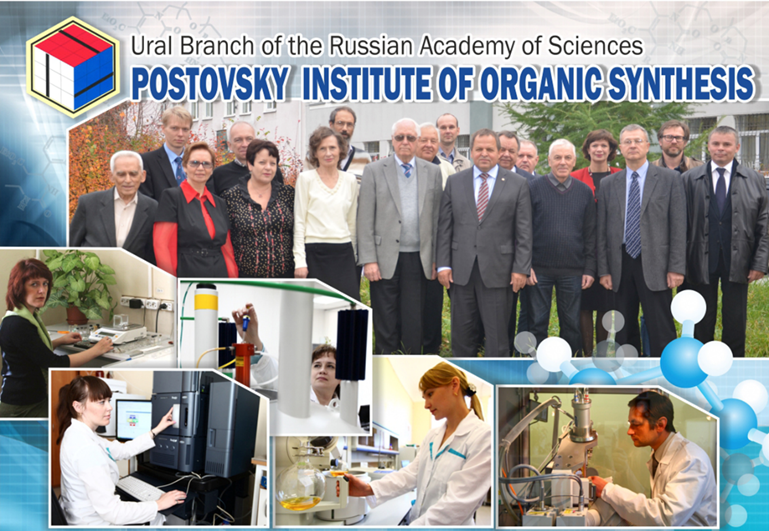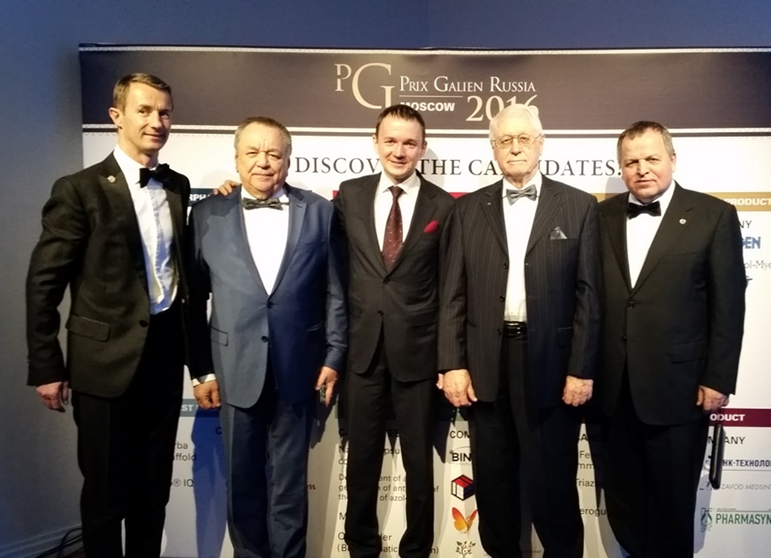I.Ya. Postovsky Institute of Organic Synthesis
I.Ya. Postovsky Institute of Organic Synthesis (IOS) is a federal state budgetary institution of science, which is directly subordinate to the Ministry of Science and Education of the Russian Federation. The early roots of what would become IOS date back to 1932, which makes the IOS one of the first scientific institutions founded within the Ural Branch of the Russian Academy of Sciences. In 1932, under the supervision of Academician I.Ya. Postovsky, the Institute of Chemistry was established, which organic chemistry laboratories are regarded to have been the basis for the IOS. The IOS was officially established in 1993 by a decree of the Russian Academy of Sciences of 26.06.93. Academician Oleg N. Chupakhin was the first director of the IOS and is now the Institute's Research Supervisor. Since 2004, Academician Valery N. Charushin has been the director of the IOS.
The Institute’s mission is to develop the methods of organic synthesis to be instrumental in meeting such global challenges as antibiotic resistance and the spread of infectious diseases, to create novel organic materials, and to train cadres of highly skilled scientists.

The trend in the Institute’s R&D and the applications of the achieved results are in line with the following priorities and prospects of the scientific and technological development of the Russian Federation:
the transition to advanced digital, intelligent products technologies and new materials;
the transition to environmentally-friendly and resource-saving energy generation, and the development of new energy sources, finding new ways of transporting energy, and designing new energy storage means;
the transition to personalized medicine, including the rational use of medicinal drugs, primarily, antibacterial agents.
The IOS pursuits scientific research in the following main directions:
Studying the structure and the reactivity of organic and heterorganic compounds, the mechanisms and intermediates of chemical reactions, and developing the physical methods for studying structures of molecules;
Creating new methodologies and techniques for organic synthesis, including asymmetric synthesis, in order to obtain new organic compounds, metallo-complexes, clusters, and to create functional materials (i.e. polymer, high-energy and nano materials) having valuable properties for various applications in engineering, defense, medicine and agriculture;
Establishing general regularities for organic catalysis and creating novel catalytic systems;
Elaborating the scientific basis and methods for resource-saving and environmentally friendly processing of natural organic raw and secondary materials;
Medicinal chemistry: template-directed synthesis of new biologically active compounds, in particular, nitrogen, oxygen, sulfur and fluorine-containing heterocycles and also aminoacids, including the predictive (and calculational) methods for forming the compounds with pre-determined properties.
Additionally, the IOS carries out research projects that are part of the national and international programs of scientific collaboration. The IOS has established wide, long-term cooperation with the institutes of the Russian Academy of Sciences (RAS), with other government-owned scientific institutions, with the institutions of higher learning, with industrial companies and enterprises. The IOS has maintained lasting relationships with N.D. Zelinsky Institute of Organic Chemistry, with N.S. Kurnakov Institute of General and Inorganic Chemistry, A.N. Nesmeyanov Institute of Organoelement Compounds, the Institute of Problems of Chemical Physics (Moscow), G.K. Boreskov Institute of Catalysis (Siberian Branch of RAS, Novosibirsk), the Institute of Chemistry (Far-East Branch of RAS, Vladivistok), the Institute of Organic Chemistry (Ufa Scientific Center of RAS), with Moscow Oncology Research Center, with the Rosatom State Atomic Energy Corporation, with the Roscosmos State Corporation for Space Activities, with universities, and other scientific organizations.
The IOS has been involved in research within the INTAS, CRDF and ISTC programs and takes part in the joint research projects with the science centers and universities from the UK, Germany, Netherlands, Italy, Belgium, Greece, Austria and Poland. The IOS has run collaboration projects with Samsung Company and the Institute of Atomic Energy (Korea), with Compugen and РАМА companies (Israel), with Janssen Pharmaceutica (Belgium), and with the Los-Alamos National Laboratory (USA).
The IOS has on its staff appr.200 people, including two Full Members and two Corresponding Members of the Russian Academy of Sciences, 18 Doctors of Science and 46 Candidates of Science. Over fifty percent of the Institute’s staff are young scientists aged below 35. The IOS comprises seven laboratories and four scientific groups.
The IOS serves as a basis for the Department of Organic and Bio-molecular Chemistry at the Ural Federal University (UrFU). Jointly with the Department of High-Molecular Compounds (UrFU) and the Faculty of Chemistry (Chelyabinsk State University), the joint laboratories have been established, and the Spectroscopy and Analysis of Organic Compounds Common Use Center UB RAS has been founded. The Science and Education Center has been created jointly by the Ural Federal University and the IOS, and the Laboratories of Medicinal Chemistry and Advanced Organic Materials have been established.
The IOS maintains scientific leadership in the field of new methodologies of organic synthesis that have found wide application in heterocyclic and medicinal chemistry. Over the last decade, the IOS has been developing metal free C-H functionalization of organic compounds, which has in its essence the processes of nucleophilic displacement of hydrogen. The SNH reactions terminology has been introduced into the scientific vocabulary by the chemists from the Urals and has now been used worldwide. TheSNH reactions have become an important tool for single-stage atom-economic PASE processes (Pot-, Atom-, Step-, Ecomonic), which are used widely in pharmaceutics and in chemistry of organic materials.

In 2012, academicians O.N. Chupakhin and V.N. Charushin were awarded with the State Prize 2011 for the significant contribution in the development of organic synthesis, for the development of innovative technology of manufacturing medicinal drugs and materials, including those of special purpose.
The IOS has developed new synthetic approaches for a series of antibacterial fluoroquinolone agents. An original method for the synthesis of enantiopure antibacterial agent LEVOFLOXACIN is patented in Japan and Korea (the research work was supported by Samsung). A series of implementation efforts has been made to put a novel antitumor agent LYSOMUSTINE® into medical practice (in collaboration with the National Medical Research Center of the Ministry of Health of the Russian Federation, Moscow). LYSOMUSTINE® has been successfully used in hospitals for the treatment of melanoma and lung carcinoma, and is distributed in Russia through the network of pharmacies. Antitumor agent ORMUSTINE® has successfully passed the preclinical trials for the treatment of primary and metastatic brain tumors.
In the IOS, a new methodical approach has been developed to producing silicon-containing hydrogels. Among silicon glycerolates and other hetero-organic products, a silicon-containing preparation SILATIVIT® is considered to be the most developed. SILATIVIT® offers a complex of useful effects on a living organism, such as wound-healing, regeneration, anti-inflammatory, transmucosal, and transdermal actions, which have made this agent in much demand for medical and veterinary applications. In addition, SILATIVIT® can be successfully used in cosmetics and medical cosmetology. The IOS has on its premises a technology facility equipped for manufacturing pharmaceutical substances. The facility has been designed and equipped to meet the standards of Good Manufacturing Practice (GMP). The IOS has been granted with a government’s license to perform technology feasibility studies and to release preproduction batches of substances for veterinary applications.
As a result of joint work of the IOS, the Ural Federal University, the Influenza Institute of the Ministry of Health of the Russian Federation, and the Virology Center of the Central Research Institute of the Ministry of Defense, a new class of substances with a broad spectrum of antiviral actions was discovered. In 2014, the first agent of this class, TRIAZAVIRIN was included in the State Register of Pharmaceutical Products of the Russian Federation (no. LP-00260 4), is manufactured by Medsintez Plant (Novouralsk), and is now on sale in pharmacies.

In 2016, the series of scientific research on the design of new antiviral substances of a new generation was awarded with the international prize GALIEN PRIX RUSSIA as the best national research project in the field of pharmaceutics. Further research in this field is on-going and have shown much promise.
The IOS keeps up close ties with the industrial companies on the regional and national scales. A cost-beneficent technology for polymerization of alpha-olefines in perfluorinated environment has been created jointly by the IOS, the Topchiev Institute of Petrochemical Synthesis (RAS) and the Lomonosov Moscow State University. Meeting the demands by the Transneft-Synthesis LLC, the IOS has developed the technology for manufacturing anti-turbulent additive to serve as a basis for an advanced technology process to be launched at a plant in Alabuga special economic zone.
In its development, the IOS has been guided with the following landmarks:
Combining the best practices and traditions of the Ural scientific school of organic chemistry with the innovative approaches to the development of basic research directed at the creation of novel methodologies of organic synthesis with due account for the state-of-the-art achievements in the world science in such essential areas of research as С-Н functionalization o